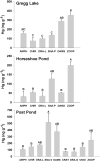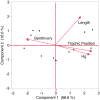Comparing nearshore benthic and pelagic prey as mercury sources to lake fish: the importance of prey quality and mercury content
- PMID: 27173839
- PMCID: PMC4939281
- DOI: 10.1016/j.scitotenv.2016.04.162
Comparing nearshore benthic and pelagic prey as mercury sources to lake fish: the importance of prey quality and mercury content
Abstract
Mercury (Hg) bioaccumulation in fish poses well-known health risks to wildlife and humans through fish consumption. Yet fish Hg concentrations are highly variable, and key factors driving this variability remain unclear. One little studied source of variation is the influence of habitat-specific feeding on Hg accumulation in lake fish. However, this is likely important because most lake fish feed in multiple habitats during their lives, and the Hg and caloric content of prey from different habitats can differ. This study used a three-pronged approach to investigate the extent to which habitat-specific prey determine differences in Hg bioaccumulation in fish. This study first compared Hg concentrations in common nearshore benthic invertebrates and pelagic zooplankton across five lakes and over the summer season in one lake, and found that pelagic zooplankton generally had higher Hg concentrations than most benthic taxa across lakes, and over a season in one lake. Second, using a bioenergetics model, the effects of prey caloric content from habitat-specific diets on fish growth and Hg accumulation were calculated. This model predicted that the consumption of benthic prey results in lower fish Hg concentrations due to higher prey caloric content and growth dilution (high weight gain relative to Hg from food), in addition to lower prey Hg levels. Third, using data from the literature, links between fish Hg content and the degree of benthivory, were examined, and showed that benthivory was associated with reduced Hg concentrations in lake fish. Taken together, these findings support the hypothesis that higher Hg content and lower caloric content make pelagic zooplankton prey greater sources of Hg for fish than nearshore benthic prey in lakes. Hence, habitat-specific foraging is likely to be a strong driver of variation in Hg levels within and between fish species.
Keywords: Aquatic food webs; Bioenergetics; Biomagnification; Contaminants; Growth dilution; Trophic transfer.
Copyright © 2016 Elsevier B.V. All rights reserved.
Figures





Similar articles
-
Species- and habitat-specific bioaccumulation of total mercury and methylmercury in the food web of a deep oligotrophic lake.Sci Total Environ. 2018 Jan 15;612:1311-1319. doi: 10.1016/j.scitotenv.2017.08.260. Epub 2017 Sep 8. Sci Total Environ. 2018. PMID: 28898937
-
Spatial patterns of mercury in biota of Adirondack, New York lakes.Ecotoxicology. 2011 Oct;20(7):1543-54. doi: 10.1007/s10646-011-0717-y. Epub 2011 Jun 21. Ecotoxicology. 2011. PMID: 21691858 Free PMC article.
-
Mercury trophic transfer in a eutrophic lake: the importance of habitat-specific foraging.Ecol Appl. 2008 Dec;18(8 Suppl):A196-212. doi: 10.1890/06-1476.1. Ecol Appl. 2008. PMID: 19475925
-
Mercury contamination in the Laurentian Great Lakes region: introduction and overview.Environ Pollut. 2012 Feb;161:243-51. doi: 10.1016/j.envpol.2011.08.051. Epub 2011 Oct 14. Environ Pollut. 2012. PMID: 22000118 Review.
-
Persistent organic pollutants and metals in the freshwater biota of the Canadian Subarctic and Arctic: an overview.Sci Total Environ. 2005 Dec 1;351-352:94-147. doi: 10.1016/j.scitotenv.2005.01.052. Epub 2005 Oct 12. Sci Total Environ. 2005. PMID: 16225909 Review.
Cited by
-
Modulators of mercury risk to wildlife and humans in the context of rapid global change.Ambio. 2018 Mar;47(2):170-197. doi: 10.1007/s13280-017-1011-x. Ambio. 2018. PMID: 29388128 Free PMC article.
-
Timber harvest alters mercury bioaccumulation and food web structure in headwater streams.Environ Pollut. 2019 Oct;253:636-645. doi: 10.1016/j.envpol.2019.07.025. Epub 2019 Jul 6. Environ Pollut. 2019. PMID: 31330355 Free PMC article.
-
Understanding drivers of mercury in lake trout (Salvelinus namaycush), a top-predator fish in southwest Alaska's parklands.Environ Pollut. 2023 Aug 1;330:121678. doi: 10.1016/j.envpol.2023.121678. Epub 2023 Apr 27. Environ Pollut. 2023. PMID: 37119998 Free PMC article.
-
A Meta-Analysis of Mercury Biomagnification in Freshwater Predatory Invertebrates: Community Diversity and Dietary Exposure Drive Variability.Environ Sci Technol. 2024 Oct 29;58(43):19429-19439. doi: 10.1021/acs.est.4c05920. Epub 2024 Oct 11. Environ Sci Technol. 2024. PMID: 39392791 Free PMC article.
-
Relationship of mercury and selenium in ocean fish frequently consumed in the Seychelles: A comparison to levels in ocean fish consumed in the US.Neurotoxicology. 2023 Dec;99:34-42. doi: 10.1016/j.neuro.2023.09.001. Epub 2023 Sep 5. Neurotoxicology. 2023. PMID: 37678724 Free PMC article.
References
-
- Back RC, Gorski PR, Cleckner LB, Hurley JP. Mercury content and speciation in the plankton and benthos of Lake Superior. Sci Total Environ. 2003;304:349–354. - PubMed
-
- Back RC, Watras CJ. Mercury in zooplankton of Northern Wisconsin lakes - taxonomic and site-specific trends. Water Air Soil Pollut. 1995;80:931–938.
-
- Baumann PC, Kitchell JF. Diel patterns of distribution and feeding of bluegill (Lepomis macrochirus) in Lake Wingra, Wisconsin. Trans Am Fish Soc. 1974;103:255–260.
-
- Becker DS, Bigham GN. Distribution of mercury in the aquatic food web of Onondaga Lake, New York. Water Air Soil Pollut. 1995;80:563–571.
Publication types
MeSH terms
Substances
Grants and funding
LinkOut - more resources
Full Text Sources
Other Literature Sources
Medical

